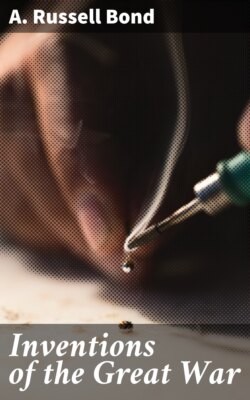Читать книгу Inventions of the Great War - A. Russell Bond - Страница 22
На сайте Литреса книга снята с продажи.
GETTING RID OF HEAT
ОглавлениеTable of Contents
The resemblance of a machine-gun to a gasolene-engine can be demonstrated still further. One of the most important parts of an automobile engine is the cooling-system. The gasolene burning in the cylinders would soon make them red-hot, were not some means provided to carry off the heat. The same is true of a machine-gun. In fact, the heat is one of the biggest problems that has to be dealt with. In a gasolene-engine the heat is carried off in one of three ways: (1) by passing water around the cylinders; (2) by building flanges around the cylinders to carry the heat off into the air; and (3) by using a fan to blow cool air against the cylinders. All of these schemes are used in the machine-gun. In Dr. Gatling's gun the cooling-problem was very simple. As there were ten barrels, one barrel could be cooling while the rest were taking their turn in the firing. In other words, each barrel received only a tenth of the heat that the whole gun was producing; and yet Gatling found it advisable to surround the barrels for about half their length with a water-jacket.
In the Maxim gun a water-jacket is used that extends the full length of the barrel, and into this water-jacket seven and a half pints of water are poured. Yet in a minute and a half of steady firing at a moderate rate, or before six hundred rounds are discharged, the water will be boiling. After that, with every thousand rounds of continuous fire a pint and a half of water will be evaporated. Now the water and the water-jacket add a great deal of weight to the gun, and this Browning decided to do away with in his machine-gun. Instead of water he used air to carry off the heat. The more surface the air touches, the more heat will it carry away; and so the Colt gun was at first made with a very thick-walled barrel. But later the Colt was formed with flanges, like the flanges on a motor-cycle engine, so as to increase the surface of the barrel. Of course, air-cooling is not so effective as water-cooling, but it is claimed for this gun, and for other machine-guns of the same class, that the barrel is sufficiently cooled for ordinary service. Although a machine-gun may be capable of firing many hundred shots per minute, it is seldom that such a rate is kept up very long in battle. Usually, only a few rounds are fired at a time and then there is a pause, and there is plenty of time for the barrel to cool. Once in a while, however, the gun has to be fired continuously for several minutes, and then the barrel grows exceedingly hot.
